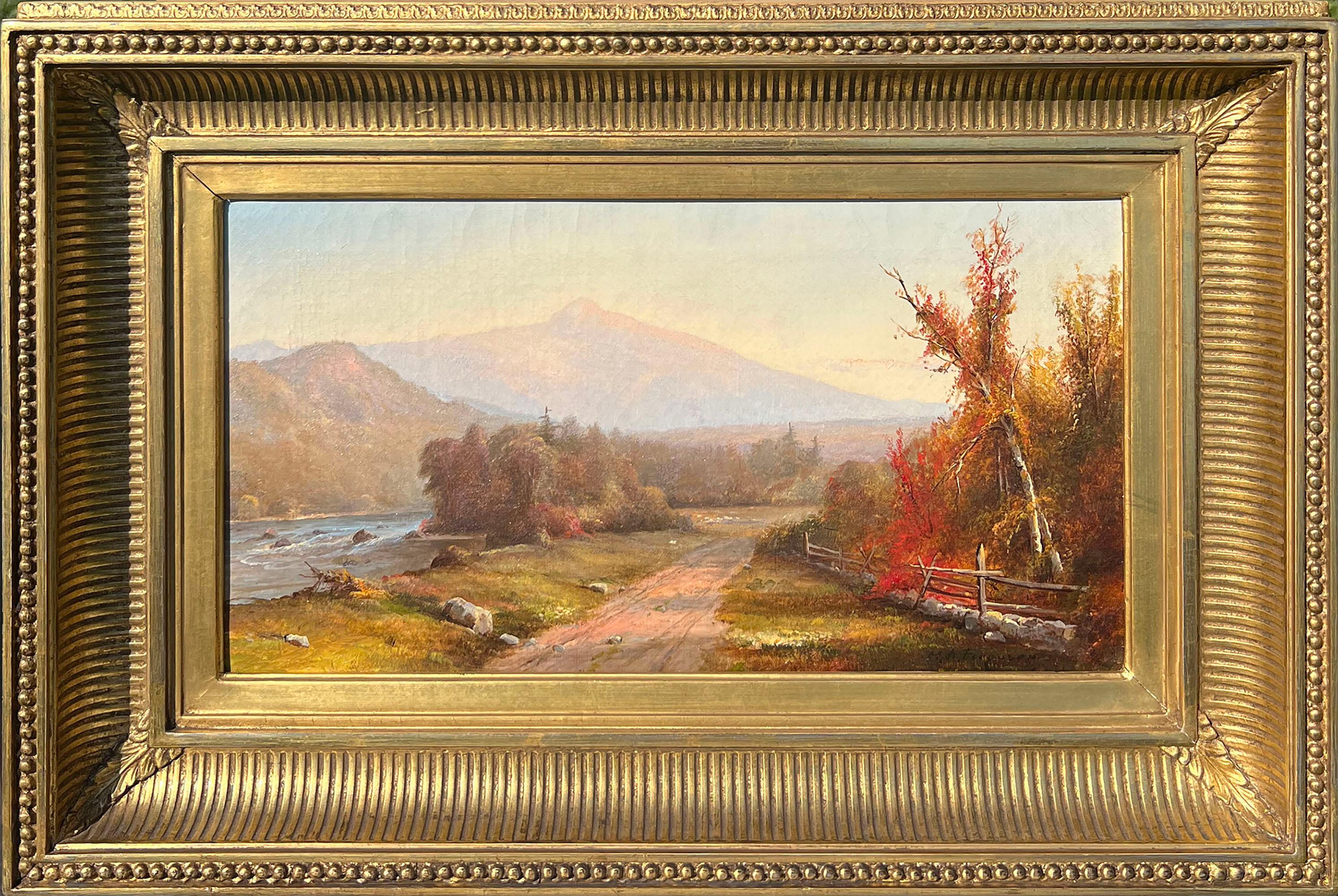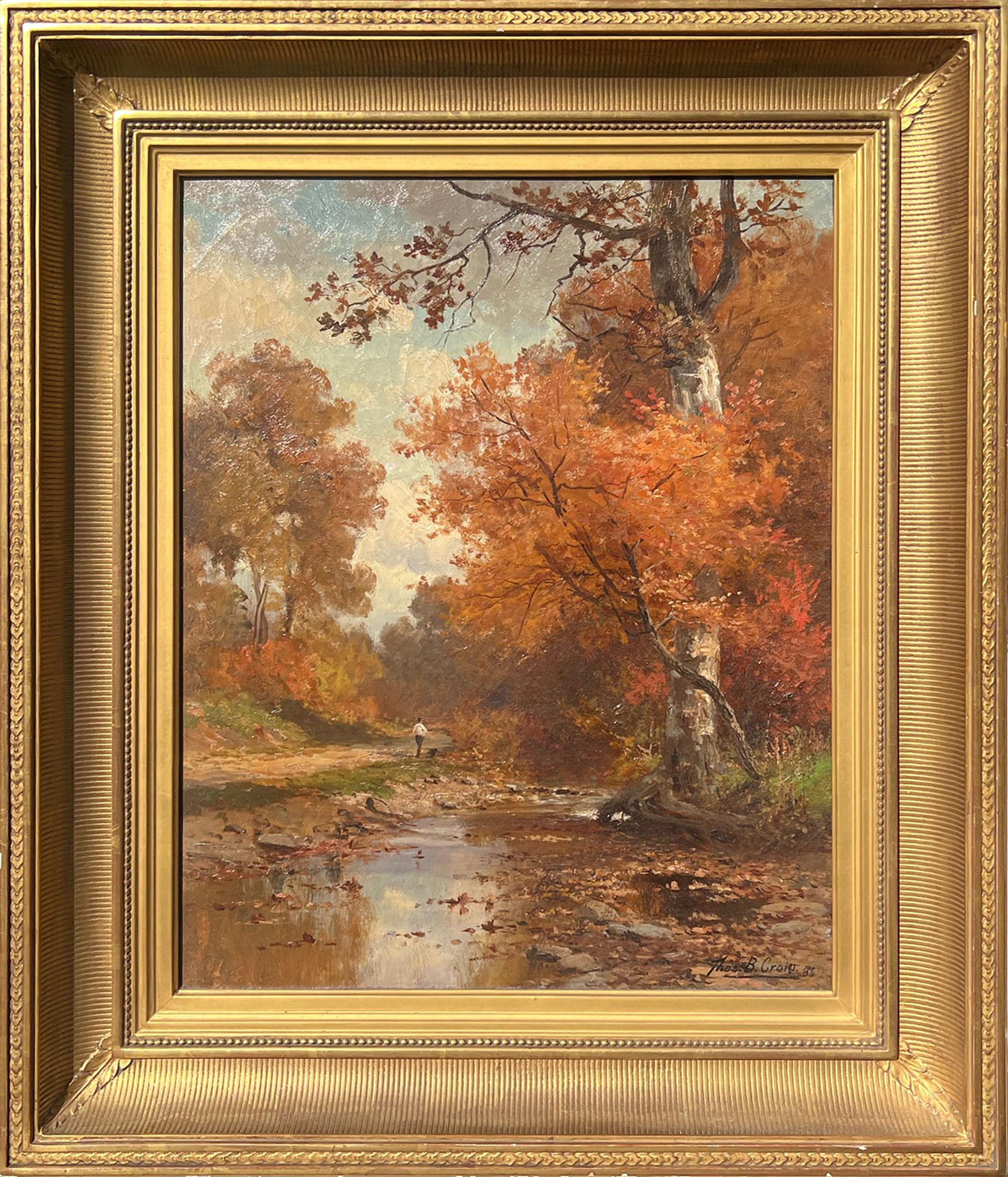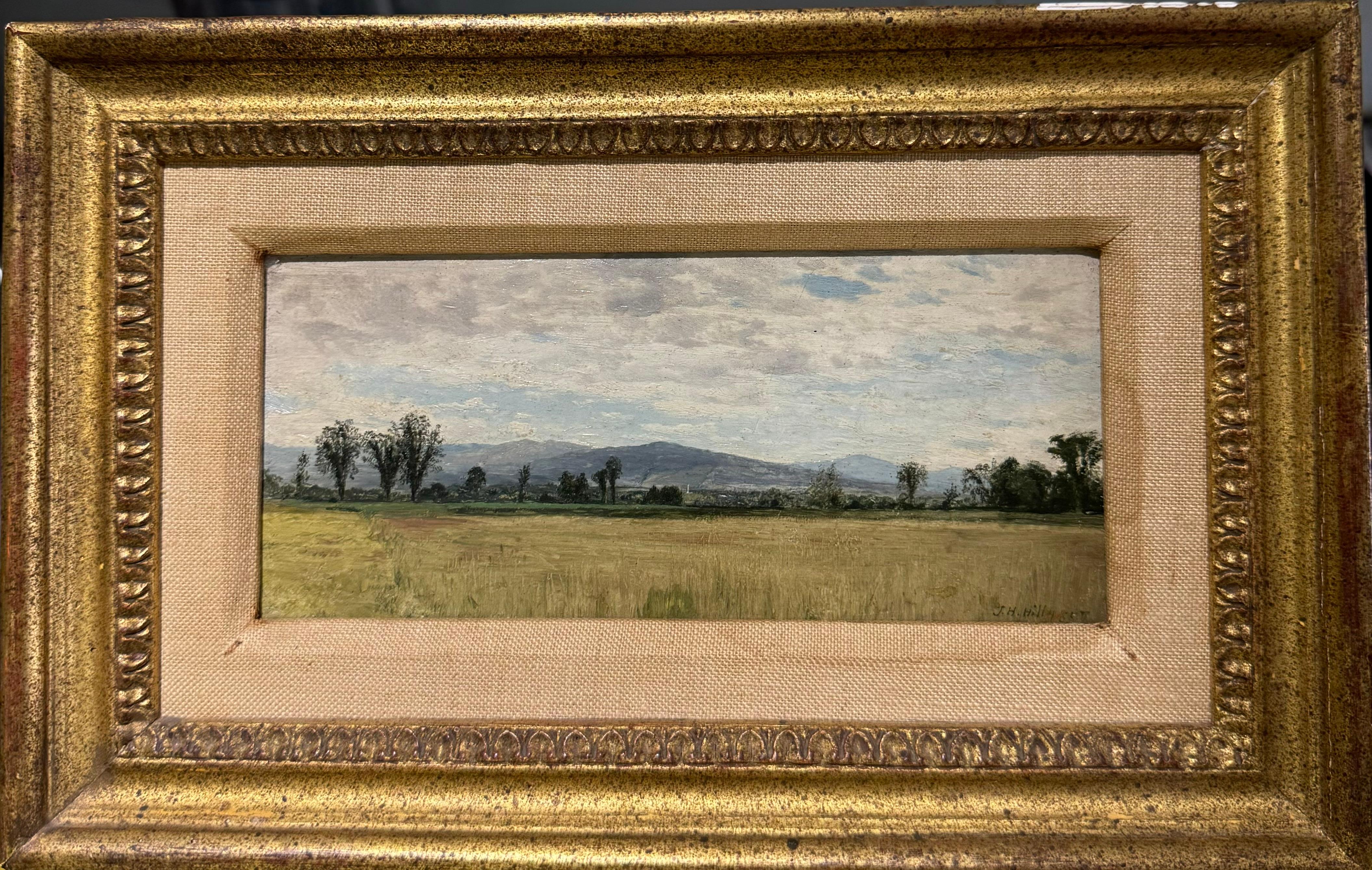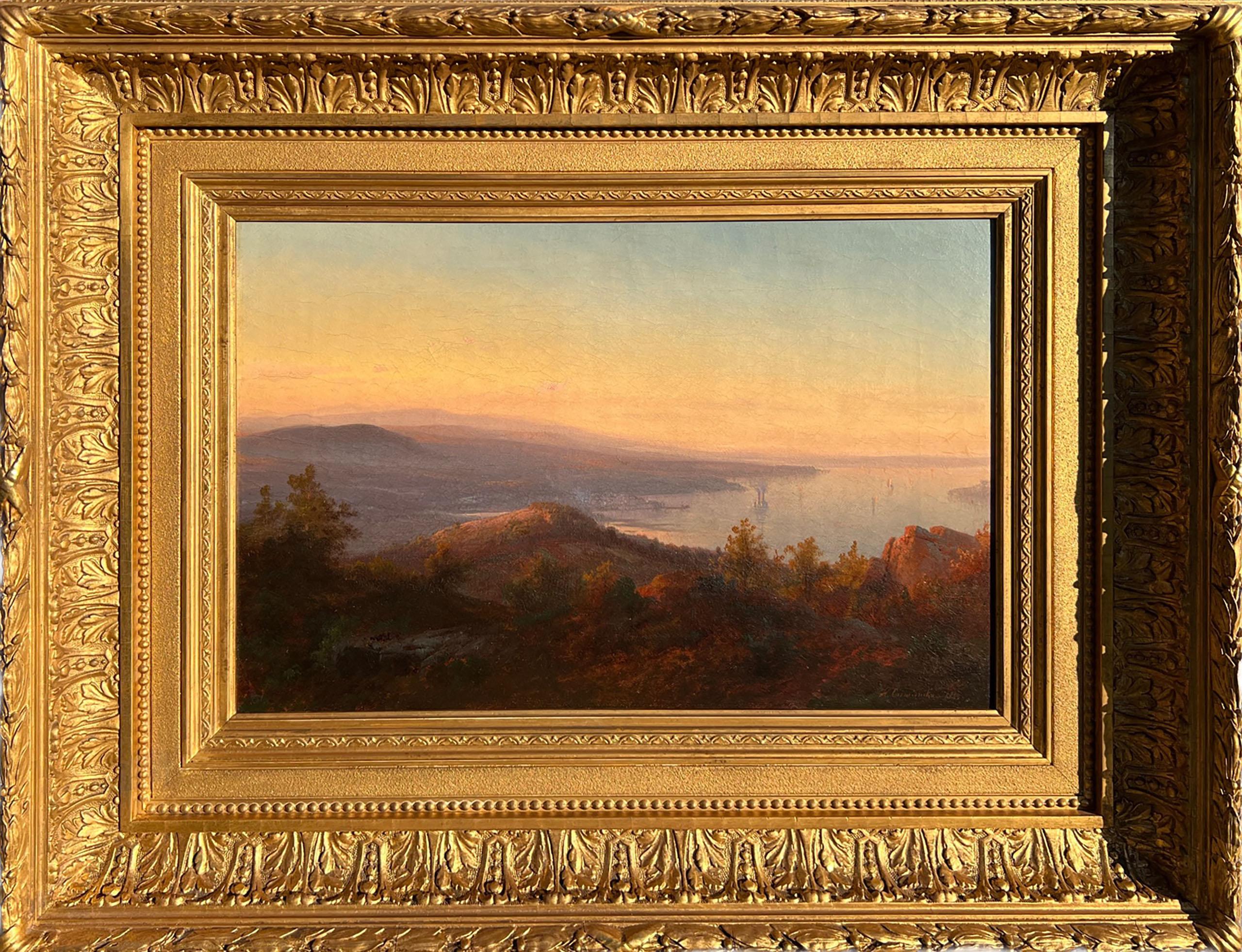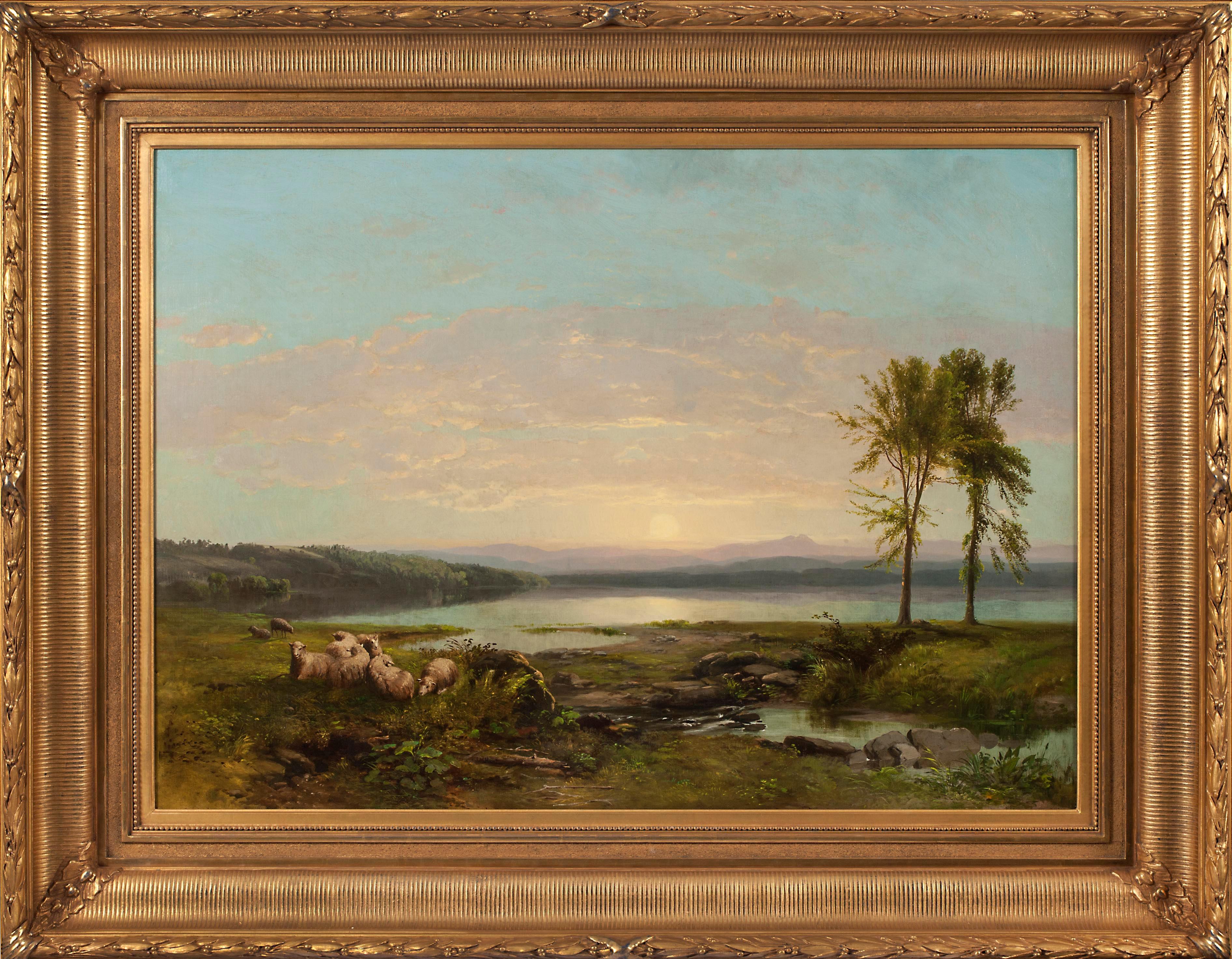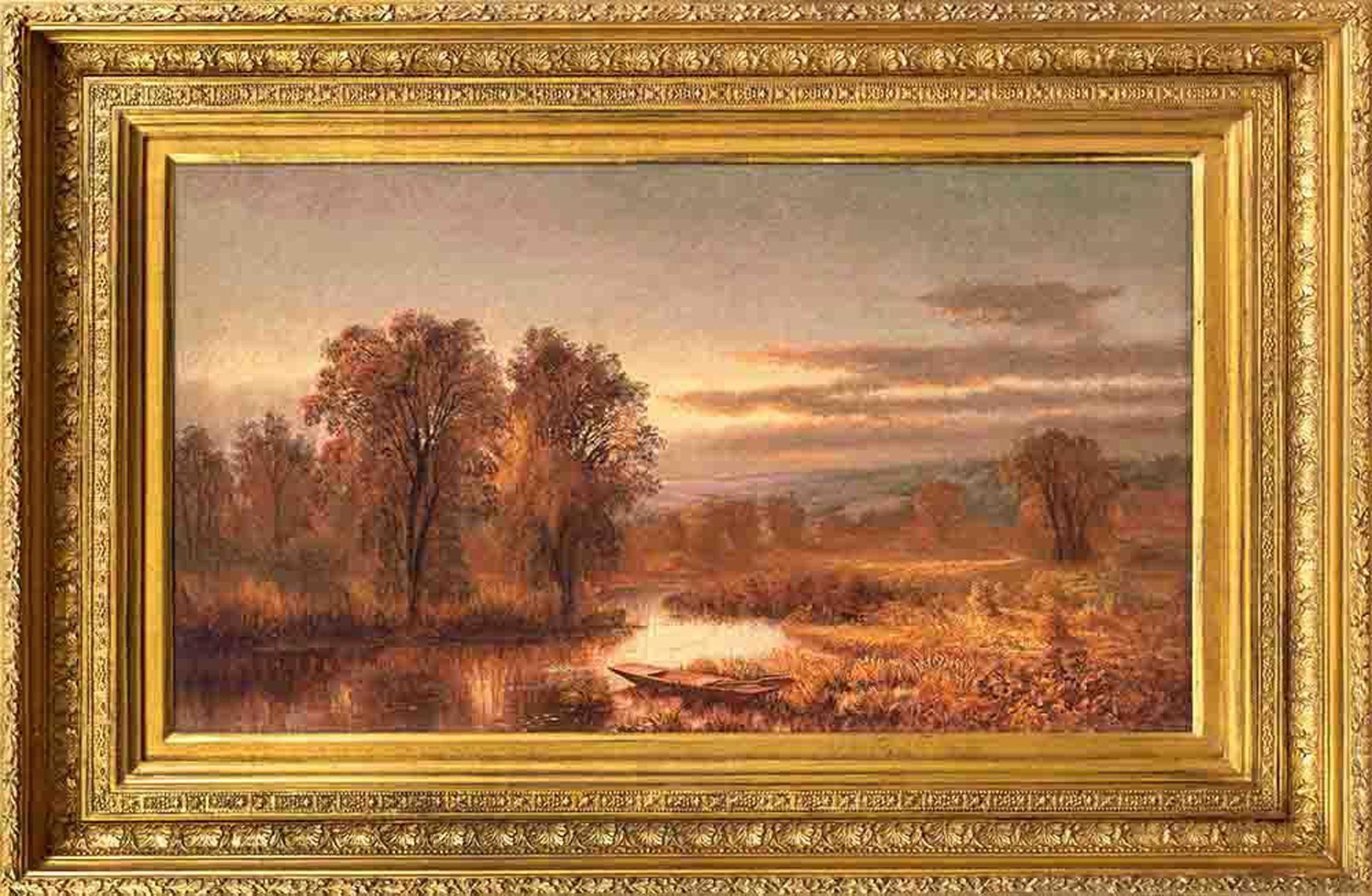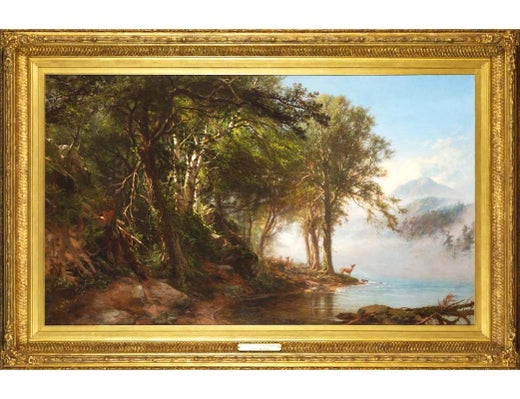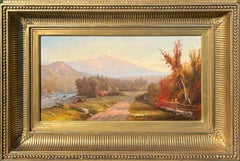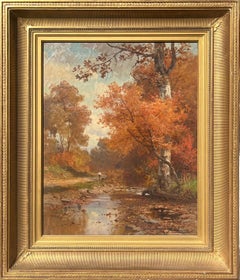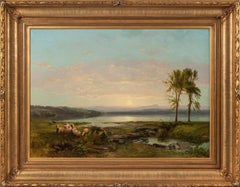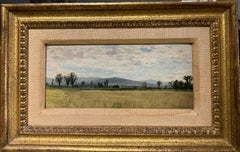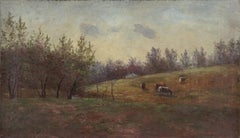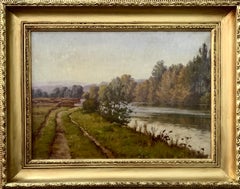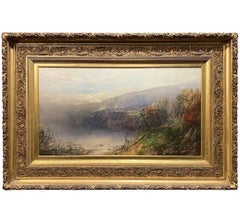Items Similar to A Day in November, 1863 by James MacDougal Hart (American: 1828–1901)
Want more images or videos?
Request additional images or videos from the seller
1 of 6
James McDougal HartA Day in November, 1863 by James MacDougal Hart (American: 1828–1901)1863
1863
$18,500
£14,053.77
€16,182.84
CA$26,466.12
A$29,030.78
CHF 14,970.08
MX$346,743.80
NOK 189,866.17
SEK 178,116.01
DKK 120,934.06
About the Item
A prominent 19th century landscapist, Hudson River School painter James McDougal Hart's (1828-1901) A Day in November, 1863 is oil on canvas and measures 10.5 x 18 inches. The painting is signed by Hart and dated 1863 at the lower left. The work is inscribed with the title, and dated 1863 on the verso. The work is framed in a period appropriate frame and ready to hang.
Provenance: Tom Colville, New Haven, CT William Union, Worcester, MA Mr. and Mrs. Craig C. Halvorson, Brookline, MA (acquired from the above January 16, 1982)
Prominent amongst the second generation of Hudson River School painters, James McDougal Hart is known for his refined and intricately crafted pastoral scenes, often featuring grazing cattle. Born in Kilmarnock, Scotland in 1828, Hart immigrated with his family to Albany, New York when he was just two years old. His older brother, William Hart (1823–1894), and younger sister, Julie Hart Beers (1835–1913), also went on to become accomplished landscape painters. James’ future wife, Marie Theresa Gorsuch, was a still life painter, and their three children, Robert
Gorsuch Hart, Letitia Bonnet Hart, and Mary Theresa Hart, all grew up to be painters as well.
James Hart began his career, as had William, in a sign and carriage painter’s shop. Unlike his brother, James returned to Europe at the age of twenty-two to receive academic training. He studied briefly in Munich, and for three years with Johann Willhelm Schirmer (1807–1863) at the Düsseldorf Academy, a center of realist pedagogy that was equally influential for fellow Hudson River School painters, Worthington Whittredge (1820–1910), Eastman Johnson (1824–1905),
Albert Bierstadt (1830–1902), and William Stanley Haseltine (1835–1900).
Returning to the United States in 1853, Hart established his first studio in Albany. A few years later, he settled permanently in New York City, later moving to Brooklyn. In the 1870s, he and his brother opened studios in Keene Valley, New York, in the heart of the Adirondacks. Hart was elected an Associate of the National Academy of Design in 1857 and a full member in 1859, exhibiting his work there consistently over the next forty years, and serving as its Vice President from 1895 to 1899. He also exhibited at the Brooklyn Art Association, the Pennsylvania Academy of the Fine Arts, the Boston Art Club, the Mechanics Institute in Boston, the Corcoran Gallery of Art, the Art Institute of Chicago, the Centennial International Exposition of 1876 (the first official World’s Fair in the United States, held in Philadelphia), and the Paris Exposition of 1889.
In 1867, prominent art critic Henry Tuckerman observed that “an exquisite truth and grace [are] characteristic of his [Hart’s] pencil,” and praised his Woods in Autumn as “one of the finest contributions lately made to the list of American successes in this field of art.” Today, Hart’s paintings are in the collections of the Metropolitan Museum of Art; the Brooklyn Museum; the Museum of Fine Arts, Boston; Harvard University’s Fogg Art Museum; the Smithsonian Museum
of American Art, Washington, D.C.; the Corcoran Gallery of Art; the Walters Art Museum, Baltimore, Maryland; and the Thyssen-Bornemisza Museum, Madrid, among others. A Day in November, 1863 is an accomplished essay by Hart which carefully notes his interest in country life. A mother and child ride an ox-drawn wagon of logs while the father steers the way.
The artist’s lessons in careful draftsmanship are reflected both in smaller details of the scene such as the perspective of the wagon’s wheels as well as in the whole shaping of the composition such as the lines of the stone fence and the white steeple spire and village buildings tucked into the nearby hills. The painting was most likely executed in the Catskill region as it is inscribed by the artist with a New York location.
- Creator:James McDougal Hart (1828-1901, American)
- Creation Year:1863
- Dimensions:Height: 10.5 in (26.67 cm)Width: 18 in (45.72 cm)
- Medium:
- Movement & Style:
- Period:
- Condition:
- Gallery Location:New York, NY
- Reference Number:1stDibs: LU2151213160852
James McDougal Hart
Hart was born in Kilmarnock, Scotland, and was taken to America with his family in early youth. His older brother, William Hart, was also a Hudson River School artist, as were his younger sister Julie Hart Beers and his two daughters, both figure painters, Letitia Bonnet Hart (1867 - Sept. 1953) and Mary Theresa Hart (1872–1942). Another niece, Annie L. Y. Orff, became an editor and publisher. In Albany, New York he trained with a sign and carriage maker— possibly the same employer that had taken on his brother in his early career. James later returned to Europe for serious artistic training, studying in Munich and as a pupil of Friedrich Wilhelm Schirmer at the Kunstakademie Düsseldorf. He is associated with the Düsseldorf school of painting. Along with most of the major landscape artists of the time, Hart based his operations in New York City and adopted the style of the Hudson River School. While he and his brother William often painted similar landscape subjects, James may have been more inclined to paint exceptionally large works. An example is The Old Homestead (1862), 42 x 68 inches, in the collection of the High Museum of Art in Atlanta, Georgia. James may have been exposed to large paintings while studying in Düsseldorf, a center of realist art pedagogy that also shaped the practices of Albert Bierstadt and Worthington Whittredge. Like his brother William, James excelled at painting cattle. Kevin J. Avery writes, "the bovine subjects that once distinguished [his works] now seem the embodiment of Hart's artistic complacency." In contrast with the complacency of some of his cattle scenes, his major landscape paintings are considered important works of the Hudson River School. A particularly fine example is Summer in the Catskills, now in the Thyssen-Bornemisza Museum in Madrid, Spain.
About the Seller
5.0
Recognized Seller
These prestigious sellers are industry leaders and represent the highest echelon for item quality and design.
Established in 2004
1stDibs seller since 2022
5 sales on 1stDibs
- ShippingRetrieving quote...Shipping from: New York, NY
- Return Policy
Authenticity Guarantee
In the unlikely event there’s an issue with an item’s authenticity, contact us within 1 year for a full refund. DetailsMoney-Back Guarantee
If your item is not as described, is damaged in transit, or does not arrive, contact us within 7 days for a full refund. Details24-Hour Cancellation
You have a 24-hour grace period in which to reconsider your purchase, with no questions asked.Vetted Professional Sellers
Our world-class sellers must adhere to strict standards for service and quality, maintaining the integrity of our listings.Price-Match Guarantee
If you find that a seller listed the same item for a lower price elsewhere, we’ll match it.Trusted Global Delivery
Our best-in-class carrier network provides specialized shipping options worldwide, including custom delivery.More From This Seller
View AllAutumn Landscape (NH) by Hudson River artist Henry A. Ferguson (1845-1911)
Located in New York, NY
Painted by Hudson River School artist Henry A. Ferguson (1845-1911), "Autumn Landscape (NH)" is oil on canvas and measures 9 x 15 inches. The painting is signed and dated 1864, at th...
Category
19th Century Hudson River School Landscape Paintings
Materials
Canvas, Oil
Autumn Stroll, 1885 by Hudson River School artist Thomas B. Craig (1849-1924)
Located in New York, NY
Painted by Hudson River School artist Thomas B. Craig (1849-1924), "Autumn Stroll along the River Path" is oil on canvas and measures 20 x 16 inches. The...
Category
19th Century Hudson River School Landscape Paintings
Materials
Canvas, Oil
Hudson River Landscape by American Artist Johann Hermann Carmiencke (1810-1867)
By Johann Hermann Carmiencke
Located in New York, NY
Painted by Hudson River School artist Johann Hermann Carmiencke, "Hudson River Landscape" is oil on canvas and measures 12 x 18 inches. The painting is signed and dated 1865 at the l...
Category
19th Century Hudson River School Landscape Paintings
Materials
Canvas, Oil
View of Lake Champlain, c. 1857 by James MacDougal Hart (American: 1828–1901)
By James McDougal Hart
Located in New York, NY
JAMES MCDOUGAL HART (1828–1901)
View of Lake Champlain, c. 1857
Oil on canvas
26 3/16 x 36 1⁄4 inches
Signed lower center
Exhibition History: National ...
Category
19th Century Hudson River School Landscape Paintings
Materials
Oil
Autumn River with Punt in the Reeds by M.J. Walters (American, 1837-1883)
Located in New York, NY
Painted by Hudson River School artist Mary Josephine Walters (1837-1883), "Autumn River with Punt in the Reeds" is oil on canvas and measures 13.25 x 23.75 inches. It is inscribed in...
Category
19th Century Hudson River School Landscape Paintings
Materials
Canvas, Oil
Summer along the Boquet River, 1875 by Julie Hart Beers (American, 1835-1913)
By Julie Hart Beers
Located in New York, NY
Painted by Hudson River School artist Julie Hart Beers (1835-1913), "Summer along the Boquet River" is oil on canvas and measures 9 x 11 inches. It is signed and dated 1875 at the lo...
Category
19th Century Hudson River School Landscape Paintings
Materials
Canvas, Oil
You May Also Like
1857 American Hudson River Rockland County Landscape Painting KENNEDY Gallery
By John Henry Hill
Located in New York, NY
John Henry Hill
1839-1922
Signed lower right
Dated: 1857
Sight size: 3 3/4 x 7 1/2 inches
Overall size: 7 3/4 x 11 1/2 inches
oil on panel
Good condition
Kennedy Gallery Label Verso
...
Category
1850s Hudson River School Landscape Paintings
Materials
Wood Panel
19th Century Hudson River School Bucolic Landscape
By John Frederick Kensett
Located in Soquel, CA
Beautiful example of the Hudson River School romantic bucolic New York autumn landscape with cows foraging. Illegible artist signature on stretcher bar (See enhanced images). Condition: very good; professionally cleaned and minor restoration upper right hand corner where paint was missing.
Unframed.
Image size: 14"H x 24"W x .75"D
Hudson River School was an informal association was America's first so-called school of painting and the dominant landscape style until the Civil War. The name derives from a group of 19th-century landscape painters working in New York state. With realistic composition, they depicted romantic views of unsettled areas of the Hudson River Valley especially lakes, rocky gorges, and forests in the Catskill Mountains. About a fourth of these artists utilized luminism or effects with special lighting techniques to convey lofty emotions through contrasts of light and dark. Included in this Hudson River luminist category were Washington Allston, Albert Bierstadt, William Hart, and Frederic Edwin Church...
Category
1870s Hudson River School Landscape Paintings
Materials
Linen, Oil
French 19th century Fall River landscape, with later afternoon sunlight
By William Baptiste Baird
Located in Woodbury, CT
French 19th century Fall River landscape, with later afternoon sunlight, Autumn trees and River bank flowers.
William Baptiste Baird was born in Chicago, moving to Paris in the 1870s where he spent most of his working life. He exhibited both in Paris, at the Salon des Beaux-Arts and at the Royal Academy in London from 1877 to 1899. In 1877 he gave his address as 47, Bloomsbury Square, London; in 1879 as 20 Cheyne Row...
Category
1880s Victorian Landscape Paintings
Materials
Oil
Autumn Landscape
By William Louis Sonntag Sr. 1
Located in Milford, NH
A wonderful Autumn landscape likely of the Hudson River Valley by the revered American artist William Louis Sonntag (1822-1900). Sonntag was born near Pittsburgh, PA and moved to Cincinnati, OH in the 1840’s to study art. He studied for a brief time with G. Frankenstein at the Cincinnati Academy of Fine Art and his idealized paintings of American wilderness and visionary paintings of imagined European ruins were commercially successful. He traveled twice to Europe in the 1850’s to improve his skills, eventually settling in New York City. He joined the National Academy of Design, where he exhibited his works for forty years. His mature works identify him with the Hudson River School of landscape painters. A romantic and naturalistic painter of his surroundings, Sonntag also created idealized paintings of Roman ruins, recalling his European trips of earlier years.
Sonntag was an Associate (1860) and Academician (1861) at the National Academy of Design, and a member of the American Watercolor Society, Artists Fund Society, and the American Art Union...
Category
19th Century Hudson River School Landscape Paintings
Materials
Canvas, Oil
"Sunset, Indian Summer" DeWitt Clinton Boutelle, Hudson River School Landscape
Located in New York, NY
DeWitt Clinton Boutelle
Sunset, Indian Summer, 1848-49
Signed and dated lower left
Oil on canvas
12 x 16 inches
DeWitt Clinton Boutelle was b...
Category
1840s Hudson River School Figurative Paintings
Materials
Canvas, Oil
"An Autumn Landscape" Jasper F. Cropsey, Hudson River School, Fall Landscape
By Jasper Francis Cropsey
Located in New York, NY
Jasper F. Cropsey
An Autumn Landscape
Signed and dated J.F. Cropsey 1898
Oil on canvas
14 x 24 inches
Provenance
Private Collection Texas, acquired in the early 1900s
Thence by desc...
Category
1890s Hudson River School Landscape Paintings
Materials
Canvas, Oil
More Ways To Browse
William Hart
Hudson River Painters
Hart Oil Paintings
Used Wagon Wheels
Mary Bonnet
H Bayer
Jules Lefebvre
Oil Painting Edgar
Oil Painting Grass
Scottish Impressionist
Terrace Painting
The Franklin Mint
Used Fishing Nets
Venice Italy Oil Painting
Vintage Paint Palette
17th Century Figures
19th Century Venice Painting
Cabin Painting
